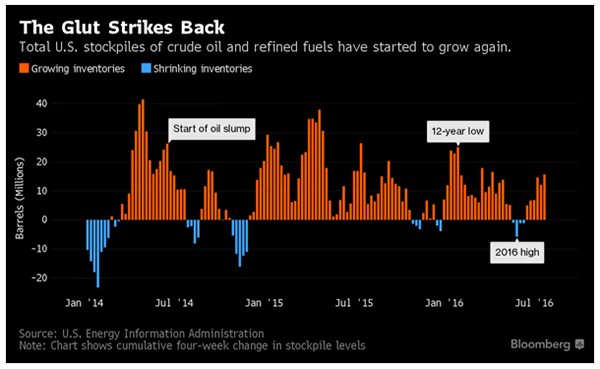Should you jump back into Energy Stocks ?

Oil prices are dragging down the market this morning as we got news that China is ramping up exports of refined products and the U.S. rig count increased again. But lately, I’ve been hearing a saying again and again in regard to oil prices: “Low prices are a cure for low prices.”
Pithy “truths” like this make for a good quip, but they tend to overlook a number of important factors, like the forces responsible for the price slump and whether those forces are actually changing direction.
For example, even though oil prices have been low for nearly two years now, we still haven’t seen a transition to a recovery for energy companies. If low prices aren’t triggering increased consumption, then the problem doesn’t lie with prices, but with the economy itself.
Oil prices are 8% off their 2016 highs made in early June. Unfortunately for many oil companies, crude prices, even at 2016 highs, were more than 50% off their highs just two years ago.
It seems that oil companies and the analysts that follow them thought the bottom was in during the early part of the year. But I see more downside in store for crude over the next month or two.
Seasonal Price Patterns Point to Problems
Americans drive the least during winter months, but with the emergence of spring comes the beginning of the summer driving season. A 2015 study from AAA shows the number of miles driven by the average person increases from 25.7 miles daily to 30.6 miles daily.
According to the International Energy Agency, the spring and summer seasons bring more expensive blends of gasoline and increased driving. The confluence of factors equates to rising prices at the pump as consumers typically use roughly 400,000 more barrels per day in crude.
U.S. oil producers prepared for the seasonal rise by adding oil rigs to account for new potential consumption, but they may have only added to their problems.
While the summer season and pricier blends usually results in higher prices, that hasn’t been the case this year.
For a seasonally strong period, crude and distillates have been extraordinarily cheap. The drop in crude oil and gasoline prices since early June indicates that something is wrong.
Making matters worse, we’re about to enter a seasonally weak period for oil and gasoline. Over the past 10 years, oil prices have generally fallen from late July through September — a period that typically sees cooler temperatures and less driving. If statistical trends continue, we could see oil prices fell even further.
Oil Glut Raises Production and Consumption Questions
Basic laws of economics tell us that when prices fall, demand rises. In other words, consumers are supposed to buy more stuff when it gets cheaper, but that doesn’t appear to be the case either. It seems that consumers are not buying the cheap stuff as quickly as oil companies may have hoped.
Even with the decline in oil prices from the early June highs and a summer driving season in full swing, a growing supply glut continues to threaten the sector and makes price increases less likely.
Perhaps more disturbing is the fact that auto sales, especially in light trucks and SUVs, have been mostly disappointing since June.Analysts are blaming slumping car sales on low fuel prices, but that makes no sense to me. Even light truck sales have been slumping since May. That month, General Motors (NYSE: GM) saw sales declines of 18% compared to the same period in 2015. Last time I checked, logic and history both point to strong car sales when fuel is cheap. Again, something here doesn’t make sense.
Airline stocks confirm something is amiss. American Airlines’ (NYSE: AAL) earnings plunged 44% in the latest quarter. And Southwest Airlines (NYSE: LUV) warned ticket prices were dropping and demand was “soft.” Its shares fell 11% the day it reported results.
With loads of inventory and waning demand from autos and airlines — two of the biggest consumers of crude — it seems low oil and gasoline prices are likely to continue.
At the end of the day, crude is facing real problems with supply and demand. Even if equilibrium is reached, I don’t see crude trading much higher than it is now.
Analysts at Goldman Sachs (NYSE: GS) — a group that has accurately predicted many of oil’s moves over the past few years — don’t expect crude to climb above $ 50 in 2016.
Even if oil prices simply stagnate, many energy companies will continue to lose money or trade at high multiples, making them susceptible to investors looking to reduce risk in an already rich market.


